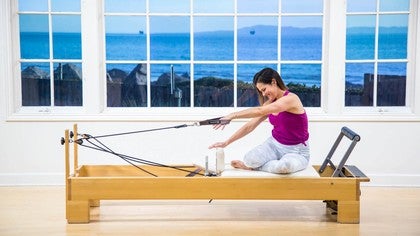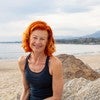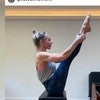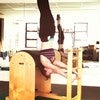Description
About This Video
Transcript
Read Full Transcript
Hello everybody. This reformer routine is focused totally on upper body strength, stability, and flexibility and refinement of your awareness of the upper body, which is so valuable for your posture. We will start on I am working a balance body machine and I've got two reds. Your intention with this is not to replicate the spring tension I've got. I actually would invite you to start really, really light So you master the movement and only then increase attention because it's not a global strength.
It's really a refinement of how to make the shoulders work more optimally and build up the tiny muscle groups. And with that in mind, we will be going right into what I call preparation for hundreds to build up this upper body strength. So I have two reds on. I'm lengthening my arms a bit, but without grounding, and the first movement really, really important is taking the skin of the armpits and pulling it towards the waist. Notice this is not into the mat.
It's down. So I've connected into my lats, and I amplify that as I bring my arms down. So the mastery of this movement is connecting into your lats. So the arms are actually a secondary movement. And you're not necessarily focused just on pulling with the arms. Notice also I've got a real nice grip on the handles versus the extension So I start to develop grip strength, which we worked on in the tutorial and just activate those muscles. Now after you've done a few of these, add, whoops, I'm gonna move down away from the shoulders.
Lifting your head and neck. Now if your spring tension is too high, you won't get very high with the upper body. I would rather you lift up more because the thoracic spine is rather tight for many people, and we want to increase this range of motion in our own practice. The next movement is triceps. So again, grounding the elbows, first of all, working without letting the shoulders pop forward too much.
They roll slightly in the socket, but you don't want a lot of that. So if you can't get further than here before the shoulder does that, that's your stopping point and then see if you can extend. But keep the elbows grounded. Once you've figured that one out and you've turned the muscles on, now you lift. And so you're working now to increase the spectrum in your body. And after you've mastered that, you add the legs.
So you could say we're developing the shaping that you will be going into for hundreds or for coordination. But in today's workout, we're only refining this part, which is the organization of the position. And it's a workout. From here, we're going into rowing. Now, I'm putting myself on one spring.
We're only doing rowing three, four, five, and six. This is a key, key exercise for developing a lot of skill in the shoulders. First one, my thumbs are in. I always like to have Do you see how I'm pulling my elbows way back? So this cuff of the shoulder is wide, and I'm squeezing my shoulder blades together hard for people to do. So I start in this shape.
And then press forward. Keep the alignment of the spine steady, and I like to see if I can get my hands as high up as I can and then move out and down. So I'm working on the full range of shoulder movement that is possible in my body and kind of pushing beyond it a little bit. We worked on loosening this area up in the tutorial and you want to now use a spring tension to see if you can control it. Rowing number four, I start down by the hips and reach as far forward as I can go. Now, this is it, up with the hands first, push into the springs, and then slowly come up, stabilizing your shape, and come on down.
So there are many, many interpretations of these movements. So there's my purpose here is to activate that back cuff of the shoulder and people really struggle with it but develop the back deltoid muscle very nicely when they work like this. Extend, reach up with the arms first and then come up in one piece and control the machine so you don't get pulled back. And down. For the next one, I'm actually lightening my spring tension even more. So I put myself on a yellow, which is super, super light.
Again, shaving can be interpreted in a lot, a lot of ways. And my focus is to open the chest. And to open these little tiny muscles here and the front because a lot of us are strong, but with strong clothes. And it's also great for all if you're teachers and you have older clients, So I'm getting into this shape. My hands are behind. Now, this is the aspiration.
How wide can you get your elbows? Imagine a stick between the elbows. It should be behind the line of the ears. So as you're going up and coming back, you keep those elbows turned out and pressed back. This is for flexibility and range of motion.
It's different from some other angles. Remember, each exercise in Pilates can be interpreted in many different ways and my goal for you all with this one is to get nice and open and changing the angle of the feet. I need the help of my hands. Yes. I know you're supposed to do it without handheld, but never mind. Nice and lifted. Just closing and open for your final work in rowing, keeping a very broad back, and be aware the shoulder blades widen, the shoulder blades move towards each other.
They widen. They move towards each other. So really connecting with those muscle groups for your own mastery of your own physiology. From here, we're going into a sequence with the long box again to work into strength. This is all leveled.
That's why I love some of these exercises. They're good for beginners. They're good for advanced people. They're very effective because the alignment is more important. Then the alignment is your secret.
So how strong you made the springs is how strong how you have to first understand the movement. Don't jump into some robotic assumption that this is the amount of spring tension I need, because honestly, people need different spring tension. Start too light and then move on. Mees just at the edge. So the whole thigh is balanced, then you can sit up straight feet are dangling so you don't lose your le use your legs to help you, which is very easy to do. So once you find your posture, you find this complete 90 degree angle.
You want your arms long. So grab wherever it's good for you. And the first movement, this is chest expansion shoulders. Honestly, I find a lot of people can't isolate their shoulder blades. So first shoulders, Once you've got the shoulder blades moving towards each other, only then add the triceps.
The goal is not that. It's not to get your hands back. The goal is to anchor your shoulder blades and have them move on to the back keep your body strong and long and lifted, and only then move these arms back. The shoulder blade muscles, the rhomboids atrophy on a lot, a lot of people. They're very weak.
They don't use them, and you want to make sure you're waking them up with this opportunity. Some people cannot do it with tension at all. So start light. As you get stronger, you can increase the spring tension and just build up more robust body now. Single. Same thing, but single.
I'm checking that my box, my chest is facing front. You can have your hand here. You can have your hand here, but don't torque all over the place. Be very diligent with the symmetry. Now same principle, shoulder, and then elbow pulls back.
The arm gets long, and you release the shoulder. Shoulder first without the body moving, elbow. And be aware of where this arm is tracking. The hand is coming close between my hip and my waist. So I'm staying really close to my body.
There's all sorts of funny things that you may find yourself wanting to do with somebody else doing if you're teaching somebody else's routine. Then once that's mastered, you add rotation. So now it's a global move, but the principles of how you're building this stay the same. That has a shoulder activates first, the elbow and then you rotate. The hips are uninvolved. So let's have a look at the other side.squared box, long arm, shoulder first and then elbow. And the hand comes to of to a 90 degree angle. And if you look at what's happening to my hand, I've got my shoulder and I've got a slight rotation happening to help the movement spiral through the full chain of the arm.
Once that's really anchored in, shoulder, elbow, rotate the ribs, right around the middle, shoulder, elbow ribs. And honestly, this is a basic move, but you want to refine it. The people like the masters at AdvancedWork, they've got these basics nailed in, and they probably revisit them over and over. And I highly highly invite you to do the same because your technique and the health in your body will increase phenomenally as you build a and you revisit the basics no matter how many years you've been doing Pilates. The next one is a very basic swan prep to start training the shoulders in relation to extension of the spine. I love this because again, it's suitable to all types of people. Just connected the, the height of the bar to be in the middle.
You want it close to the same height as the box or lower, honestly, to start with. So first of all, here I am. My head is on the bar, and I'm connecting my shoulders onto my back. And just going out and in a few times, it's like a press out. Very light. For me, I have a lightweight.
You can build up a stronger weight if you can be stable. And now we'll get into the swan, and I'll show you the progressions because you want to start low, press out. Pull the shoulders onto the back. So notice this, I'm actually slightly contracting my my shoulder blades and then lifting up without letting them go to here. So many, and then you bend down. I'm moving up a little bit, pressing out.
Shoulder blades widening and then lifting and doggedly keeping those shoulder blades squeezing together. So many people lift up in swamp on or in yoga, they're doing cobra and this whole upper body is actually collapsed forward. I'll just demonstrate people are here and we want them here because you will turn on your whole upper back as your stabilizer so your chest can come open. So better to work at a low level, train those muscles to become of your vocabulary and then increase your flexibility as you do this. Because It just builds a super healthy back and a super healthy extension that's supported by the back body.
I hope you can see what I'm doing. And the good news about this is you may start and be kind of disappointed with how much you can how little you can lift up, but your flexibility will kick in once that's or come back once you've figured out how to bring that into place. So from here, we, here we are. We have worked to create more strength and stability in the shoulders and semicir circles is a great place to stretch this range of motion. Going to put the foot bar down.
And for semi circles, I love to have the two outer springs connected up So I don't know how your your reformer is set up, but if you can have it wide, that's great because then you can drop your hips down between those two springs. Set your feet up in a semi in a pilates v. And here we go. Get your hands as low down as you can on the shoulder rest, and now I'm getting my feet in place. Why do I want this? I want my hands as extended as I can have them. They're literally by my ears.
Remember in the tutorial, I worked on the arms going back. This is an amazing place to get an opposite stretch with the same direction. So as I start to roll down, you will probably find that stiff part of your back being opened And I like to tell people to push their arms as high up as they can. It will open up your armpits and your side ribs. Amazing, amazing opportunity to get into parts of your body. We seldom get into and then come back in. So this is a lovely length in the body, but here we are pushing into the hands, rolling down and creating flexibility in the thoracic spine, in the ribcage, pressing out.
Rolling up, coming in reversing this, I'm pushing out, and here we go again, rolling down and imagining if you can't quite get it, opening up the ribs, opening up the sternum, pushing into your hands and opening up the armpits one more time like this, and rolling down. Amazing, amazing, amazing opportunity to stretch a delicious part of your body that often doesn't get to move very much. Our ribs are like little accordion. They should be like an accordion. They should be able to open and close.
And unfortunately, as we get older, they get glued up, but not us if we do Pilates. Now, we've done a lot of opening, we've done a lot of building, but we need a little bit of work into our triceps. So this is just simple tricep dips you can do in them on the foot bar here. But if you stand up, remember the shoulders are on the back and then lowering and lifting, seeing if you can feel the triceps firing up. The more further out the legs are, the more weight. Is being taken by the arm, so that's how you build up your strength. And from there, we are just, again, focusing on arm strength.
This is preparation for tendon stretch which is an advanced move on the reformer, but we're just getting into the basics of it. So you want to lift. And now can you lift one leg and one leg? So you're holding your body up. Can you pull your hips in? Sit down.
Extend your legs out. Press lift up and pull your hips in and sit down. So now we get to try that on the reformer properly. So let's get the foot bar up. I've got two springs and my feet are up. So this is the beginning version of how I will get people into this.
You press a woo. This is too strong for me today. I'm going to move on to a blue and a red. I was on two revs. So the goal of remember is not as there's not weight lifting. This is giving you an anchoring.
So I'm pressing out. By the way, my sit bones are just in front. I'm bending over and then I'm lifting. So here's my position, and then with control, I'm bringing the carriage in. So that's the beginning intro level of how to work this, bending over getting used to holding your weight on your hands, and coming up. And now if you are up for it, notice what I've just done.
I'm rounding and I'm pressing with my lats and then bringing the hips out. And coming in. Such fun when you have the flexibility and the control to do it. And this is most definitely upper body strength as well as leg strength. It's full body.
So I hope you found a little bit of insight into your upper body, a little bit of stimulation, some new ideas of how to approach the work. And the upper body is called in a lot of places, the second powerhouse, because it's as important as the lower powerhouse. So enjoy.
Beginner Reformer: 20-Minute Classes
Comments
You need to be a subscriber to post a comment.
Please Log In or Create an Account to start your free trial.


















